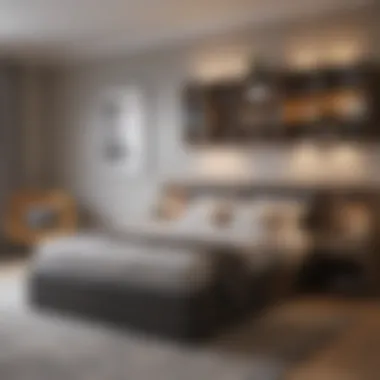Smart Strategies for Small Bedroom Furniture Arrangement


Intro
Arranging furniture in a small bedroom can be quite a challenge. Many face issues converting limited space into a comfortable and stylish environment. The goal here is strategic layout and furniture selection, both contributing to functionality and aesthetic appeal.
Creating a practical living space involves careful planning. By utilizing efficient designs, it's possible to enhance comfort without compromising on style. This guide aims to offer an assortment of strategies for organizing small bedrooms effectively.
Materials:
For an improved arrangement of your bedroom furniture, you will need a few essential items. Here is a breakdown of materials with relevant measurements:
- Measuring tape – at least 25 feet, for accurate room dimensions
- Graph paper – preferably 8.5 x 11 inches, to design a layout
- Pencil – keep several on hand, for clear markings on paper
- Ruler – a straight edge measuring 12 inches or more
- Furniture pieces – with dimensions:
- Storage boxes or bins – as per need, looking for under-bed options at 30 inches long
- Set of tools – includes screwdriver, hammer, and level
- Bed frame (twin or full-size, adjust size as needed)
- Nightstands (area of 20x20 inches)
- Dresser (ideally 30 inches wide and 18 inches deep)
- Bookshelf (around 30 inches in height and width)
DIY Steps:
Step 1: Measure the Space
Using the measuring tape, measure your bedroom carefully. Note the dimensions along with the location of doors, windows, and electrical outlets. Map these measurements on graph paper to achieve proportional representation.
Step 2: Layout Options
Start arranging your furniture on the graph paper. Each isolated section should represent different furniture items. Tweak placement until it feels right, paying attention to the flow of movement.
Step 3: Consider Multi-Functional Pieces
Select furniture that can perform multiple functions. A bed frame with storage, or a nightstand that holds books and displays decor can save significant space. Accessible storage solutions can help maintain order.
Step 4: Assemble and Arrange
After finalizing the layout, bring the furniture into the room per your outline. Place large pieces first, then layer on smaller bits. Ensure equilibrium in placement – avoid overcrowding any particular area.
Technical Aspects:
Here are few tools necessary for a successful furniture arrangement:
- Screwdriver for assembling bed frames
- Hammer and level for ensuring stability
- Estimated time of installation could range between 2 to 4 hours, depending on complexity
Critical techniques that can improve your experience include stacking storage and creating vertical spaces with wall-mounted items, to elevate clutter from surfaces. Use lighter or spaced-out finishes where possible, enhancing the perception of depth and space.
Troubleshooting Tips:
- Unstable Furniture: Use jointers to glue joints. Make sure all screws are tightened.
- Motility Issues: Reassess flow; ensure no barriers in common pathways.
- Aesthetic Concerns: Incorporate textiles or small decor to add warmth without weighing down the space.
Understanding the Space Requirements
Understanding how to make the most out of your small bedroom is essential. Space limitations mean that each decision counts more. When you arrange furniture consciously, you increase functionality and comfort. If the layout does not match your needs, everyday life can become frustrating. Furthermore, this comprehension allows you to select appropriate furniture pieces.
Measuring the Room Dimensions
Before anything else, measuring the room itself is crucial. This initial step ensures that any furniture you plan to bring in fits well without overwhelming the actual area. Use a tape measurerto record the length and width of the room. Do not forget to measure the height as well, especially with taller furniture items.
When taking measurements, note down door placements and window locations. This attention to detail will help you in identifying where your furniture can be safely positioned for easy access. Accurate measurements help in preventing future issues like stumbling over furniture or blocking windows.
Potential Need For These Measurements:
- Choosing a suitable bed size
- Determining adequate spaces for walkways
- Planning for wardrobe or storage placement
Conclusion from this measurement study means verifying how much floor space you can assign to getting needed furniture in. Validate your numbers occasionally, too, since sometimes walls are not perfectly straight. Even slight differences in dimension can impact design significantly, especially in small spaces.
Identifying Crucial Areas
After measuring, the next step is to identify crucial areaswithin the bedroom. These zones typically include sleeping, storage, and dressing spaces. Each area serves a significant purpose and should remain functional without interference from other zones.
Start off by evaluating the most important functions your bedroom must fulfill. Do you need room around your bed? Should you allocate enough space for a desk or some seating?
To create functionality, categorize these areas. Make a plan for furniture deciding placement: the bed should be accessible while ensuring ease of everyday activities. Cluttered lines of movement may make using essential space more complex.
Among these Considerations:


- Dense furniture full of decorative items: Try avoiding any overcrowded placements that ruin clarity of purpose.
- Zoning off Areas: A rug can aid in defining spaces, making it easier to visualize each function.
The arrangement of these areas influences how the bedroom will be used daily. When organized effectively, you can create helpful hints within strict limitations, providing comfort’s necessary serenity.
Remember: Especially in small bedroom layouts, recognizing these areas helps facilitate flow and movement, making a delightful affect on daily requests one may put upon the space.
Establishing a Functional Layout
Creating an effective and functional layout is crucial when arranging furniture in small bedrooms. The layout determines how well the space can be utilized while providing comfort and accessibility. An intentional layout not only contributes to better organization but also enhances the overall atmosphere of the room.
Several specific elements need consideration in establishing a layout. First, it is essential to prioritize the layout around any existing features, such as windows, doors, and electrical outlets. This positioning impacts everything from natural lighting to usability. A well- planned layout leads to improved flow and can considerably widen the usable space.
Furthermore, it incorporates a balance between personal style and functional arrangements. Successful setups make it easy to engage with one’s sleeping area while allowing access to key features without obstacles. Let's delve into the particular components of a functional layout.
Using the Focal Point
To increase a small bedroom's appeal, leveraging a focal point can elevate the entire layout. The focal point is the item or area that draws attention first. Common choices include the bed, stunning wallpapers, or eye-catching artwork.
When determining a focal point, consider positioning your bed to highlight it best, placing it against a wall that can make it the center of attraction. This can help create a feeling of openness in the bedroom, giving it dimension.
Also, avoid clutter around the focal point to maintain its integrity against the rest of the room’s decor. A clean difference draws the eye effectively.
Creating Defined Zones
Defining zones within a small bedroom can greatly enhance its functionality. Zones do not have to be formal walls but can refer to distinct purposes within the same space, such as sleeping, reading, and working. Each area should have its own purpose to maximize efficiency.
One potential method for defining these zones is the use of area rugs. A rug can mark the boundaries of a particular zone, indicating clearly where different activities happen. Similarly, utilizing furniture such as bookshelves or side tables can create soft separations that inform motion and activity.
Intentional placement of furniture helps achieve clear divisions. For instance, position a desk away from the bed to limit distractions when it is time to rest. Likewise, always consider the use of light and color schemes in each zone to assure consistency across the entire area.
Traffic Flow Considerations
Ensuring smooth traffic flow in a small bedroom is critical. Well-planned furniture placement allows for fluid movement without hindrance. It involves positioning items in a manner that creates unobstructed pathways, offering quick access to essential areas, such as and the closet or bathroom.
The general rule is to leave a minimum of 24-30 inches for major walking paths. This enables occupants to move comfortably about their space. It’s helpful to follow an established plan before moving items.
In addition, regularly step back to assess how effectively the space is utilized and if people can meander smoothly through it. Flexibility in layout allows for easy adjustment and upgrading along with the occupant’s changing needs. Consider making tiny adjustments to ascertain what flows well.
The layout's alignment sets the atmosphere and usability of the entire small bedroom. Making careful choices about furniture placement benefits both functionality and aesthetics.
Combining focal points, defined zones, and consideration of traffic flow builds a foundational layout well suited to small bedrooms’ unique requirements.
Prioritizing Essential Furniture Pieces
Prioritizing essential furniture pieces is crucial when arranging a small bedroom. This process can significantly influence both functionality and comfort in a limited space. Careful selection of furniture prevents overcrowding and enhances a serene environment. Understanding which items are non-negotiable is the foundation for creating a cohesive layout. Each piece should serve a purpose and contribute to the overall ambiance without restricting mobility.
Choosing the Right Bed Size
The bed is the focal point of any bedroom. Thus, selecting the right bed size is essential for maximizing space. A bed must be comfortable while fitting seamlessly without overpowering the room. For small bedrooms, a double bed or a full bed are often the best choices. They provide adequate sleeping space and allow for movement around it.
When considering the right bed size, it is important to visualize how it will fit into the overall layout. For example, measure wall lengths before deciding on frame dimensions. Leaving some room around the bed facilitates easy access to other areas of the bedroom.
Incorporating Multi-Functional Furniture
In small spaces, every piece of furniture should utilize multiple functions. The use of multi-functional furniture turns a small bedroom into a smart environment. A bed with under-bed drawers or a sofa bed can save space. Likewise, a fold-out desk can be an excellent addition for those needing a workspace without clutter.
Identifying each furniture component’s various tasks is key to successful integration. The goal is to select items that adapt based on changing needs. This approach allows flexibility for entertaining guests, working from home, or having quiet time.
Selecting Compact Nightstands
Compact nightstands are a practical solution in small bedrooms. They help maintain essential storage without consuming valuable floor space. Selecting the right nightstand requires consideration of several factors such as height, depth, and design.


A low-profile nightstand is ideal for a smaller bed, creating a balanced look. Look for designs equipped with drawers or shelves, which can be beneficial for storing reading materials and personal items. This not only prevents additional clutter but also ensures that everything remains within easy reach during the night. A well-chosen nightstand can complement the bedroom's overall style while maintaining its functionality.
Exploring Storage Solutions
In small bedrooms, the need for effective storage becomes paramount. Managing clutter can maximize floor space and enhance functionality. By adopting the right storage strategies, it is possible to keep the room organized while maintaining a stylish aesthetic. Several methods are available, each offering unique advantages. Here, we will examine key solutions for optimal storage ranging from utilizing under-bed spaces to incorporating built-in shelves. These options enable efficient use of every available area, promoting a serene and functional environment.
Utilizing Under-Bed Storage
One of the easiest ways to enhance storage in a small bedroom is by combating the void under the bed. Many beds sit a few inches off the ground, presenting an often-overlooked area for stowing away items. Here are some practical ideas for under-bed storage:
- Storage Bins: Clear bins can provide visibility while keeping dust off clothes or shoes.
- Rolling Drawers: They allow for easy access. Choosing drawers designed to fit under the bed includes compartments for neatness.
Using this space efficiently can significantly reduce clutter. It’s a practical hiding spot for out-of-season clothing, spare linens, or unused items, thus maintaining a cleaner visible area. A well-utilized under-bed space keeps belongings accessible yet out of sight, creating a more open atmosphere.
"Under-bed storage can free up precious closet space, allowing for a more organized room overall."
Incorporating Vertical Space
Vertical space is a fantastic resource. In most small bedrooms, wall areas are the perfect place for additional storage. Using vertical space effectively can transform a cluttered room into a serene escape. Consider these strategies:
- Tall Bookshelves: These help to store books and display decor, drawing the eye upward and creating the illusion of height.
- Wall Hooks and Racks: Great for accessories like hats, bags, or jackets. They make efficient use of walls instead of floor space.
Believe it or not, combining these ideas can provide more organizational opportunities and maximize the aesthetic appeal of the room. Vertical storage stops the feeling of being cramped. With proper decorating techniques, vertical applications can tie design together while offering function.
Implementing Built-in Shelves
Built-in shelves are another useful storage solution. They create customized, integrated storage that keeps clutter to a minimum while utilizing wall space efficiently. Unlike freestanding shelving, built-ins can optimize unusual nook or corner spaces prominently found in smaller rooms. Consider these advantages:
- Tailored Dimensions: Fit them to fit any segment, providing an elegant, seamless look.
- Enhanced Aesthetics: When done correctly, built-ins are visually appealing and add value to your home.
Additionally, built-in shelves can serve dual functions. For instance, they can display books while offering a spot for decorative items. Their functionality can elevate interest and character in an otherwise utilitarian space.
Harmonizing Color and Light
Color and light play significant roles in how a small bedroom feels and functions. Properly harmonizing these elements convinces the eye and creates an illusion of space, enhancing the overall comfort of the environment. Small bedrooms have the potential to feel airy and inviting, which is crucial for relaxation and restful sleep. In this section, we delve into the strategies to use color and light expertly together, focusing on how these considerations can greatly influence the functionality and aesthetics of the space.
Choosing Light Color Palettes
The color palette of a small bedroom can make or break the ambiance. Light colors like pastels, soft whites, and pale grays are often best because they reflect more natural light. So, walls painted in a soft beige can extend the feel of the space while creating a cozy atmosphere.
- Reflective Surfaces: Consider using satin or eggshell finishes instead of matte ones. These surfaces reflect light, adding to the perception of size.
- Accent Colors: You may add depth by incorporating darker hues through smaller decor items. Throw pillows, bed linens, or artwork can introduce subtle contrast without overwhelming the space. These should be used sparingly to maintain a spacious feel.
- Experiment with Styles: Would you like a delicate blend of contemporary and classic? Such styles invite personality without choking out openness.
Optimizing Natural Light Sources
Natural light sources are a gift. Is it possible to maximize what comes through the windows in your small bedroom? Indeed. The following considerations contribute to a well-lit space:
- Window Treatment: Opt for light, airy curtains instead of heavy drapes. Sheer or translucent materials allow ample sunlight while providing privacy.
- Placement: When arranging furniture, ensure larger pieces, like beds or dressers, do not block windows. If a piece must be near a window, a low-profile bed frame is ideal.
- Reflective Elements: Place furniture pieces that can reflect light. For instance, incorporating a light-colored desk against a window can help amplify the effect of natural lighting.
Strategic Use of Mirrors
Mirrors can serve as both furniture and decor while doubling your perception of space. Correct placement of mirrors can significantly enhance both light and the visual feel of the room.
- Positioning: Hang mirrors across from windows so they catch and reflect daylight. This tactic can multiply the brightness and attractively disperse it throughout the room.
- Size Matters: Opt for sizeable mirrors to create the illusion of a larger room. Consider mirrored furniture that can blend storage with aesthetics.
“Using mirrors effectively isn’t just about style; it’s about expanding the very nature of your space.”
By carefully selecting colors and optimizing available lights alongside mirrors, small bedrooms can evolve into well-loved havens of individuality and comfort. A measure of thoughtfulness helps create a peaceful place for relaxation, functioning at an ideal level in terms of space and personal taste.
Personalization and Style Considerations
Personalizing your small bedroom is essential. It ensures that the space feels unique and comfortable. Without personalization, a room can seem cold and uninviting. From the color scheme to decorative items, personal touches bring warmth and identity. Designing a functional layout that works for you is important. However, integrating your taste adds a layer of satisfaction and individuality to the environment.


Reflecting Personal Taste
Reflecting personal taste necessitates understanding what resonates with you. Are you drawn to minimalist designs or do you prefer vibrant colors with diverse patterns? Knowing your style helps in selecting proper furniture and accents.
- Colors: Choose colors that evoke your emotions. Soft colors can promote calmness while bright tones can boost energy.
- Textures: Different textures can add elements of comfort. Consider linen, silk, or even bristle as choices for bedding or curtains.
- Artwork: Display art pieces that speak to you, whether they are paintings, photographs or framed quotes. They create a focal point and personalize the space.
In this space, personal items can also be prominent. Maybe a collection of books and family photos. They transform a generic room into a one that embodies your journey, making it ultimately comforting.
Balancing Function with Aesthetic Appeal
Balancing function and aesthetics requires thoughtful consideration. The furniture selected should support how you live in your bedroom while also reflecting your design preferences. Striking a harmony between practicality and beauty allows small spaces to not only serve a purpose but also feel cohesive and pleasing to the eye.
- Multi-functionality: Look for furniture that meets multiple needs. For instance, a bed with storage drawers underneath can maximizze space while remaining stylish.
- Style but not Excess: Choose items that also compliment each other without overcrowding the area. A simple nightstand is practical and can also have artistic edges or a special finish that reflects your style.
- Simplicity: Sometimes, less is more. Adopting a simple design with only key pieces can help maintain spaciousness. Selecting a few quality decorative items over numerous can maintain clarity while still showcasing your style.
A well-designed small bedroom accomplishes both function and style, directing attention away from limitations and instead, showcasing sophisticated choices that embody you.
Good design eliminates the struggle, allowing usability to provide insight into personal preferences while exuding character and charm.
Common Mistakes to Avoid
When arranging furniture in a small bedroom, being aware of common mistakes can significantly improve the overall functionality and aesthetic appeal of the space. Many times, the excitement of designing can lead to choices that diminish the effectiveness of a small area. By understanding these pitfalls, homeowners can make informed decisions, creating a more comfortable and usable environment.
Overcrowding the Space
One of the more frequent blunders occurs when individuals overcrowd their small bedrooms with excessive furniture. It is tempting to fit too many pieces in a smaller area, especially if each item holds sentimental value or is essential for daily life. However, while maximalism can work in larger spaces, in small bedrooms, it leads to clutter, affecting both comfort and usability.
To avoid this mistake, prioritize essential pieces and be selective about what enters the room. A well-chosen bed frame and a small nightstand could offer more than an array of furniture options that fill up the area without providing real functionality.
- Evaluate each item's necessity. Will it serve a clear need?
- Consider the use of open space as part of the design. Empty areas contribute to a calmer atmosphere.
Removing a single chair or decorative piece may make the whole room feel more spacious. This openess allows light to flow freely and promotes an inviting atmosphere. By limiting furniture, you minimize maintenance and create ease of movement within the room.
Neglecting Traffic Flow
Ignoring traffic flow can significantly hinder how a space is utilized in a small bedroom. It is crucial to ensure that individuals can move freely without bumping into furniture. Poor layout can disrupt not only comfort, but the purpose of the bedroom itself.
To facilitate better traffic flow, considerhow you naturally move through the space. For instance, do you frequently move towards the closet or the bathroom? Arrange items in such a way that there are clear paths to these areas while still preserving functionality.
A well-executed layout maximizes utility. Use visual blocks or markers in the room configuration to confirm understanding of how people will use the space. This might mean leaving the area around the bed open or consider placing furniture at angles, which also create movement dynamics without obstruction.
Final Considerations for a Small Bedroom
When working with small bedrooms, there are many factors to consider that affect both function and visual appeal. Final thoughts are crucial in ensuring that your choices create a cohesive environment while meeting personal needs. This is often the make-or-break moment for achieving the desired arrangement and comfort in a small space.
Reviewing what has been done helps one to affirm decisions. Furthermore, it creates a checklist of what works effectively. Flow and access remain paramount; clients, such as housewives and homeowners, should take note that ease of movement significantly impacts overall enjoyment of the space.
Surprisingly, flexibility can sometimes be overlooked. As needs change, being able to adapt current arrangements can be the key to maintaining efficiency. In fact, continuous assessment of layout not only improves immediate experience but enhances lasting satisfaction with one’s living environment.
Reviewing Arrangement Choices
Evaluating furniture arrangement choices is a major step when aiming for optimal functionality in a bedroom.
- Have the core needs been met? For instance, essential items should facilitate daily routines.
- Look closely at whether safety concerns are addressed. A cluttered room can pose various hazards.
- Think about aesthetic coherence. Items should feel connected and contribute to a unified design.
By examining these aspects, you will uncover possibilities that might have initially been overlooked. This process allows individuals to select furniture wisely while ensuring necessary space is allocated to promote rest and relaxation. As choices are reviewed thoroughly, one can determine alternate configurations that provide better utilization, which significantly enhances the quality of the space overall.
Adapting the Layout Over Time
Adapting layout over time is an important consideration for maintaining success in a small bedroom. Life evolves. Sometimes, needs can shift as interests and styles change.
A few thoughts on how to adapt over time:
- Embrace flexibility: Emphasize modular pieces such as bed frames that lift or unfold. This permits changes without committing to completely new furniture.
- Regular assessment: Every few months, think about the layout and see if efficiency can be upped. Life changes quickly; your bedroom should too.
- Listen to feedback: If you share the space, seek input from other residents. Diverse perspectives can elicit valuable insights into improvements needed.
Essentially, viewing your bedroom's arrangement through a lens of adaptability makes it resonant with your life experience day in and day out. Having that dual focus on both function and individual lifestyle creates a meeting point for necessity and pleasure.
Adaptation supports longevity in design choices, ensuring continued harmony with personal lifestyle demands.
Thus, as time passes or priorities shift, holding your space to critical considerations will lead toward a rewarding living atmosphere.







